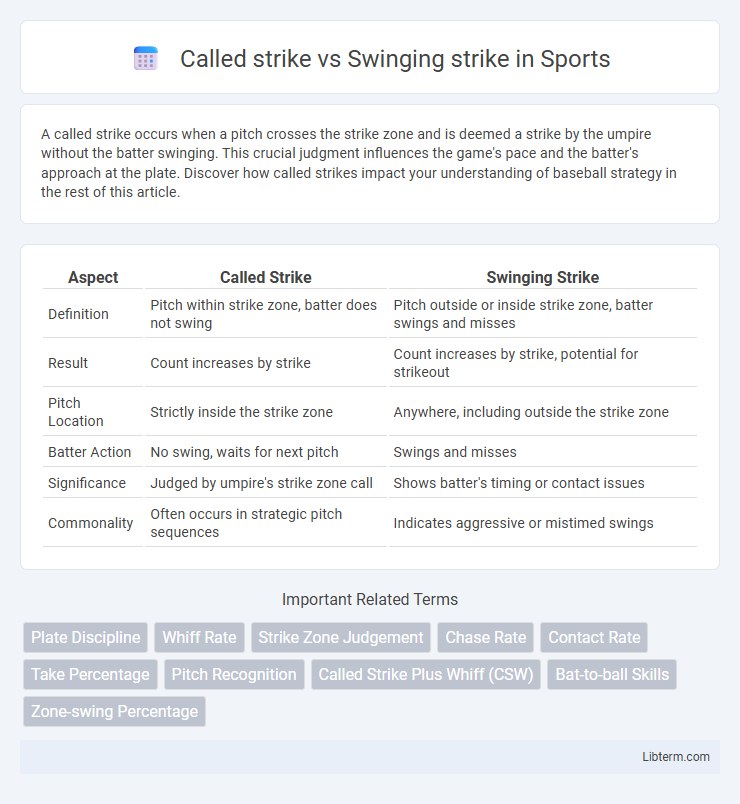A called strike occurs when a pitch crosses the strike zone and is deemed a strike by the umpire without the batter swinging. This crucial judgment influences the game's pace and the batter's approach at the plate. Discover how called strikes impact your understanding of baseball strategy in the rest of this article.
Table of Comparison
| Aspect | Called Strike | Swinging Strike |
|---|---|---|
| Definition | Pitch within strike zone, batter does not swing | Pitch outside or inside strike zone, batter swings and misses |
| Result | Count increases by strike | Count increases by strike, potential for strikeout |
| Pitch Location | Strictly inside the strike zone | Anywhere, including outside the strike zone |
| Batter Action | No swing, waits for next pitch | Swings and misses |
| Significance | Judged by umpire's strike zone call | Shows batter's timing or contact issues |
| Commonality | Often occurs in strategic pitch sequences | Indicates aggressive or mistimed swings |
Introduction to Called Strikes and Swinging Strikes
Called strikes occur when a batter does not swing at a pitch that the umpire deems within the strike zone, resulting in a strike without batter action. Swinging strikes happen when the batter actively swings but misses the pitched ball entirely, demonstrating a failure to make contact. Both types of strikes are crucial metrics in evaluating a pitcher's effectiveness and a batter's plate discipline.
Defining Called Strike: Meaning and Context
Called strike refers to a pitch that the umpire deems within the strike zone, which the batter does not attempt to hit, resulting in a strike being recorded. This judgment is based on the official strike zone defined by the rules of baseball, generally extending from the midpoint between the batter's shoulders and the top of the pants to just below the kneecap. The distinction between a called strike and a swinging strike lies in the batter's action, with a called strike occurring without a swing, affecting pitching strategies and batter statistics differently.
Understanding Swinging Strike: What Sets It Apart?
A swinging strike occurs when a batter actively swings at the pitch but misses, contrasting with a called strike where the batter does not swing, and the umpire deems the pitch within the strike zone. The distinction lies in batter intent and contact attempt, with swinging strikes reflecting aggressive hitting and impacting metrics like chase rate and strikeout likelihood. Pitchers and analysts use swinging strike rates to evaluate pitch effectiveness and batter behavior during at-bats in professional baseball.
Key Differences Between Called Strike and Swinging Strike
Called strikes occur when the batter does not swing, but the pitch passes through the strike zone and is called a strike by the umpire, while swinging strikes happen when the batter swings and misses the ball entirely. The key difference lies in batter action and umpire judgment: called strikes depend on the pitch location relative to the strike zone, whereas swinging strikes depend on the batter's swing outcome. Evaluating pitch tracking data and swing metrics helps distinguish these two types of strikes in baseball analytics.
Impact of Called Strikes on Pitchers and Batters
Called strikes significantly influence pitcher performance by increasing strike counts without requiring a swing, enhancing pitching efficiency and control over the strike zone. For batters, called strikes heighten pressure to make contact, often leading to altered swing decisions or a more cautious approach at the plate. This dynamic directly affects game strategy, as pitchers exploit called strikes to dominate at-bats and reduce hits, while batters must adapt to avoid strikeouts.
Significance of Swinging Strikes in Game Analytics
Swinging strikes indicate a batter's inability to make contact with a pitched ball, serving as a critical metric in game analytics to assess hitter aggressiveness and timing. These strikes help predict pitcher effectiveness by highlighting swing-and-miss rates, directly correlating to strikeout potential and defensive strategy adjustments. Tracking swinging strikes enables teams to refine pitching approaches and optimize player performance through data-driven insights.
Factors Influencing Called Strikes in Baseball
A called strike occurs when the umpire declares a pitch within the strike zone without the batter swinging, heavily influenced by umpire positioning, pitch location, and batter stance. Pitch velocity, movement, and deception also play critical roles in whether a pitch is judged a strike or a ball. Understanding the strike zone's dimensions and the batter's eye level enhances analysis of called strike frequency in professional baseball.
Pitch Selection and Its Effect on Swinging Strikes
Called strikes occur when the batter does not swing at a pitch within the strike zone, often influenced by strategic pitch selection aimed at exploiting batter tendencies and zone awareness. Pitchers use pitch selection to vary speed, location, and movement, increasing the likelihood of inducing swinging strikes by deceiving batters and disrupting timing. Effective pitch sequencing blends fastballs, sliders, and changeups to maximize swinging strike rates, significantly impacting pitcher performance and game outcomes.
Statistical Analysis: Called vs. Swinging Strikes
Called strikes occur when the batter does not swing, and the pitch is within the strike zone, resulting in a strike credited to the pitcher without batter contact. Swinging strikes happen when the batter swings and misses, often indicating a pitcher's ability to deceive or overpower the hitter, and are key metrics in evaluating pitching effectiveness. Statistical analysis shows swinging strikes often correlate more strongly with strikeout rates and pitching dominance, while called strikes provide insight into batters' plate discipline and the umpire's strike zone consistency.
Called Strike or Swinging Strike: Which Matters More?
Called strikes demonstrate a batter's inability to protect the strike zone and directly influence umpire judgment, often leading to crucial strikeouts without a swing. Swinging strikes indicate aggressive or mistimed swings, reflecting a hitter's struggle with pitch recognition and timing. Evaluating which matters more depends on context: called strikes impact pitch appeal and control, while swinging strikes reveal offensive weaknesses and contribute to strikeout rates.
Called strike Infographic

 libterm.com
libterm.com